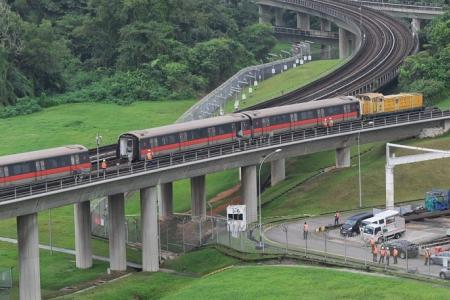500k out of 2.8m MRT journeys hit daily during EWL disruption
About 500,000 out of 2.8 million train journeys were affected each day during the severe East-West Line (EWL) disruption that crippled services between Jurong East and Buona Vista stations from Sept 25 to Sept 30.
This means the disruption – one of the worst to hit Singapore’s MRT system in its 37-year history – affected more than one out of every six MRT trips taken by commuters each day.
Addressing questions filed by more than 18 MPs in a ministerial statement on Oct 15, Transport Minister Chee Hong Tat apologised again for the significant inconvenience caused by the disruption.
He told Parliament that the Land Transport Authority (LTA) will mete out penalties should investigations reveal any lapses, and rail operator SMRT will bear the costs of the disruption regardless of the outcome of the probe.
Some details of the incident can be determined only after investigations have been completed, he noted.
“As to the root cause, including why the axle box dropped, as well as learning points to improve our responses and prevent future incidents, these are issues which the investigations will cover,” he added.
Describing the Sept 25 disruption as “a setback”, Mr Chee said Singaporeans are understandably concerned about what it means for the safety, reliability, and resilience of the MRT system.
“These are also our priorities,” he said, adding that the incident will not shake the public transport sector’s determination to do better.
“While we do our best to avoid disruptions, incidents may still happen from time to time,” the minister added. “What is important is how we respond to the incidents, and how we learn from them to strengthen our resilience against future disruptions,” he said.
Mr Chee stressed that commuter and worker safety was the top priority throughout the recovery process.
This was why LTA and SMRT took the necessary time to complete the repairs and conduct rigorous testing before resuming train service on Oct 1, he said.
Across the MRT system, there are multiple layers of safety controls in place, he added.
As the regulator, LTA imposes safety standards that are aligned with international best practices. Operators that do not meet these standards will be subject to penalties, and face additional regulatory conditions and monitoring if necessary.
Mr Chee said LTA also imposes maintenance performance standards as part of its rail licensing conditions, and there are audits by independent external assessors.
Responding to questions by Workers’ Party MP Louis Chua (Sengkang GRC) and Mr Saktiandi Supaat (Bishan-Toa Payoh GRC) about predictive maintenance capabilities, he said the rail operators have installed monitoring systems to detect potential defects where feasible, and use special vehicles to scan the tracks to pick up issues.
However, Mr Chee said he would not comment on whether such systems could have detected risks leading up to the disruption on Sept 25, citing the ongoing investigations.
On the issue of reliability, Mr Chee said LTA and the rail operators take this seriously. While significant progress has been made over the past decade, this continues to be a work in progress, he added.
The minister noted how the MRT network has maintained a mean kilometres between failure (MKBF) of at least 1 million train-km since 2019, which he said is comparable with the most reliable overseas metros. In contrast, the MRT network here had an MKBF – a measure of rail reliability – of 67,000 train-km in 2012.
Mr Chee said LTA has been working with the rail operators since 2011 to improve their maintenance regimes. LTA has upgraded signalling and power systems and invested in infrastructure like signalling simulation centres, to improve the operators’ ability to diagnose and remedy different faults.
A recently completed $2.6 billion renewal programme for the North-South and East-West lines has also helped to boost reliability, he added.
LTA’s monitoring of MKBF and rail licensing conditions has also ensured that the rail operators here invest sufficiently in maintenance to minimise disruptions, he said.
In his statement, Mr Chee made the point that Singapore’s public transport network, with six MRT lines and a sizeable fleet of about 5,800 public buses, is more resilient and better able to cope with disruptions than before.
The mitigation measures put in place during the six-day EWL disruption allowed most public transport users to continue with their journeys, albeit with additional travelling time, he said.
Noting that the public transport system was able to cope thanks to the efforts by the respective bus operators and staff on the ground, Mr Chee said planned expansions to the rail network over the next decade will further improve resilience.
However, the minister said the public bus network still plays a key role in complementing the rail network here.
“That is why, even when we need to rationalise bus services, we retain at least one trunk route that runs parallel to MRT lines,” he added.
Get The New Paper on your phone with the free TNP app. Download from the Apple App Store or Google Play Store now


